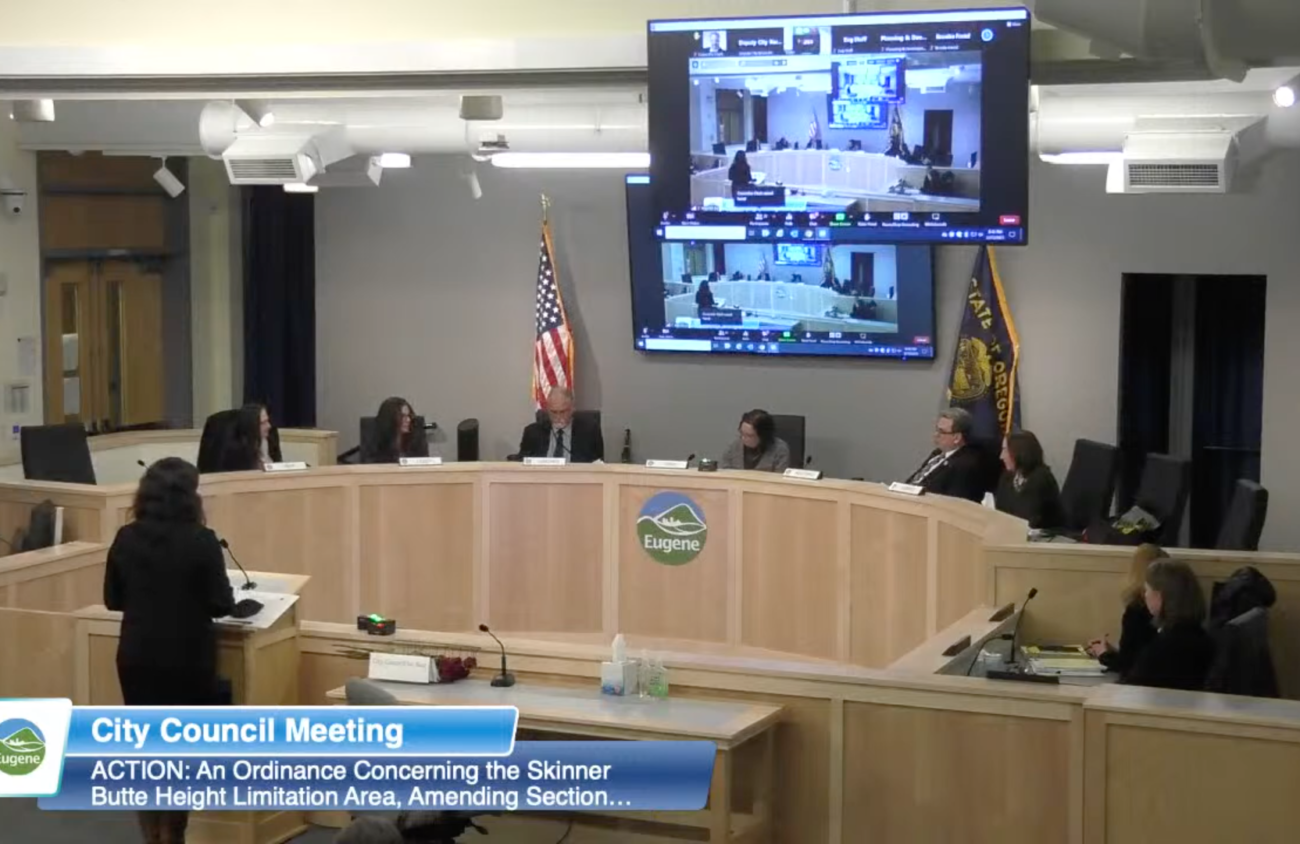Buildings near Skinner Butte can now be a little bit taller.
At a Feb. 13 Eugene City Council meeting, councilors voted 4-2 to increase the height limitations on properties near Skinner Butte from 70 feet to 100 feet.
Supporters of the height limitation increase, which Obie Companies requested and the city says is part of a goal to connect downtown with the Willamette River, cited the need to encourage developers to build up, especially if the city won’t expand its urban growth boundaries. The opponents of the decision — Councilors Emily Semple and Matt Keating — cited environmental concerns.
The last time that the Eugene City Council increased the height limitation for buildings near Skinner Butte was in 2018, Dylan Huber-Heidorn, a development analyst with the city, said at the meeting. But the city’s height restriction was initially implemented in 1968, around the time that Ya-Po-Ah Terrace was built near Skinner Butte, which at 212 feet is the tallest building in Eugene.
The decision allows taller buildings on plots of land between 5th and 6th avenues and Oak and Pearl streets, as well as 4th and 5th avenues and Willamette and Pearl streets. Much of this area has property owned by Brian Obie, including his 5th Street Public Market and nearby housing and hotels. Members of the public spoke out about Obie benefiting from the regulation change at a Jan. 17 public forum on the decision.
The request to increase the height limit comes as Obie Companies has proposed to construct two apartment developments near the 5th Street Market Expansion. The developments will be similar to Obie’s Gordon Lofts luxury apartments, according to meeting materials. These buildings will be seven stories — about 100 feet tall, with about 313 housing units built above ground-floor retail.
According to Feb. 13 meeting materials, increasing the height limitation near Skinner Butte also fits with a few goals set forth by the city, such as stimulating housing development, facilitating development between downtown core and the Willamette River, and emphasizing “5th Avenue as a Great Street, especially now that it connects to the river.”
The city isn’t necessarily calling 5th Avenue a “great street,” rather it’s referring to a state funding program that focuses on adding safety improvements and increasing access to walking, biking and transit, according to an Oregon Department of Transportation webpage. The program, which has $50 million from the Biden administration’s Infrastructure Investment and Jobs Act, focuses on “main streets” in communities throughout the state.
“This is a motion that causes me great distress,” Semple said. “I see both sides. Housing is critical; an extra 100 units is pretty critical. However, I don’t think this is the only place we could put another 100 units, and I’m really concerned about any blocking of the butte. The butte belongs to all of us, and we’re putting a lot of expensive apartments along the butte and the river.”
She added that allowing taller buildings near Skinner Butte would be a slippery slope that would spread throughout the city. “I don’t think this is the right thing to do,” she said.
Councilor Keating said that he’s “100 percent in favor of growing up, not out, especially around transit corridors.” But because he hadn’t received responses from city officials about his environmental concerns with increasing the height limitation, he was voting no.
At the earlier Jan. 17 public forum, Keating had asked city staff to look into the impact taller buildings could have on migratory birds.
At that meeting, three councilors — Councilors Randy Groves, Lyndsie Leech and Greg Evans — disclosed that they had met with a representative from Obie’s development firm, who supports allowing taller buildings near Skinner Butte.
Before voting on changing the height limitations near Skinner Butte on Feb. 13, Groves said the city has to do something about encouraging housing if it’s not going to expand its urban growth boundaries or allow development in its wetlands. Allowing taller buildings near the butte won’t affect the scenery but instead views of nearby smaller buildings, he said.
“We need housing, we need housing, we need housing,” Groves said. “We have a 1.8 percent vacancy rate, which is very low compared to the national average, which runs around 6 to 8 percent.”
